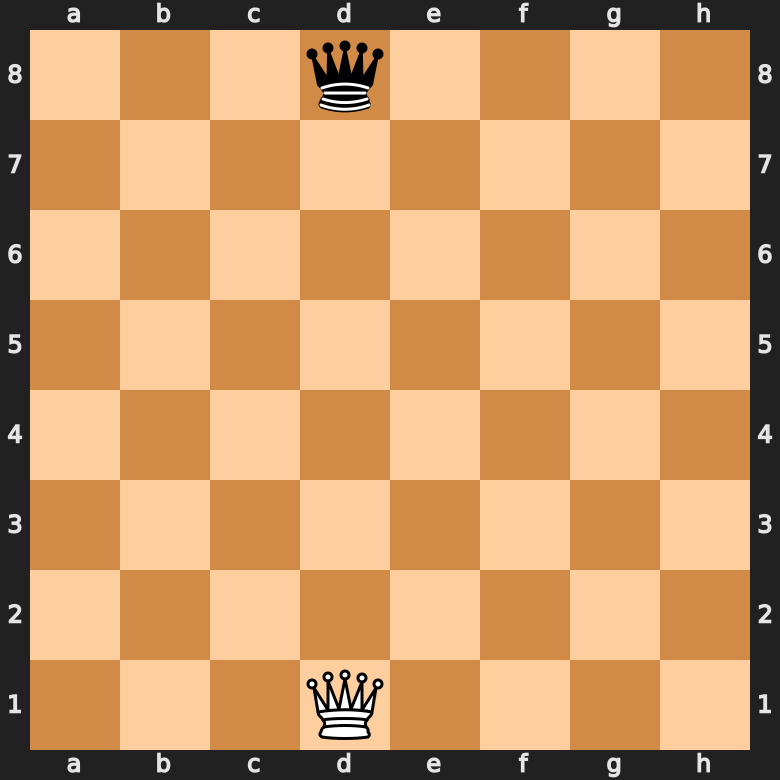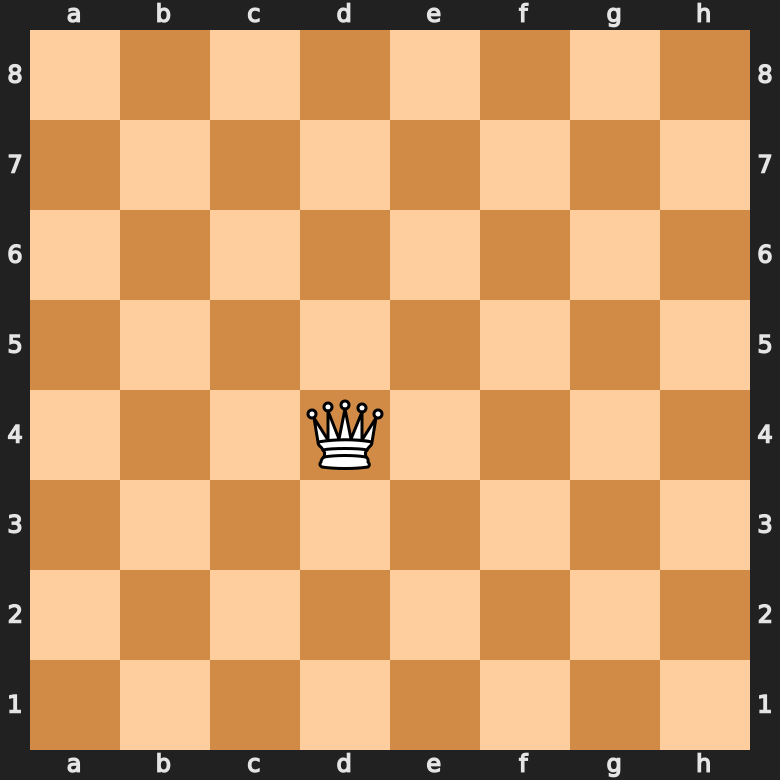The Queen in Chess ♕: Full Guide
Thanks to her agile movement, the queen is widely considered the strongest piece in chess 💪. She can move any number of squares vertically, horizontally, or diagonally, thus combining the movement patterns of a rook and bishop into one piece.
Position of the Queen on the Chess Board
The white queen starts the game on d1, while the black queen starts on the opposite side of the board on d8, as shown in this picture of the starting position:

Beginners often misplace the queen, either due to the wrong board setup or swapping her position with the king. An easy way to get the queen position right every time is remembering, that the queens always want to match their outfits. Meaning, the white queen starts on a light square (which is always d1) and the black queen starts on a dark square (d8). If you’re still struggling with the setup of the board or queens in particular, this detailed guide on how to properly set up a chess board might help you.
In the starting position the queen is surrounded by her king, pawns, as well as a bishop. The queen cannot jump over other pieces, meaning she needs to have a clear path to move along. In practice, that usually means moving a pawn to free the queen’s movement.
How the Queen Moves in Chess
The queen is allowed to move any number of unoccupied squares in any directional line, so either horizontally, vertically or diagonally. However, she cannot combine those movement patterns into one move. Here is an example of the queen’s movement:

As you can see, the queen combines the movement patterns of rook and bishop.
There are just a few limitations to the queens movement:
- The queen can only move in straight lines (horizontally, vertically, and diagonally), but not combine those movement patterns. For example, moving 5 squares horizontally and 3 squares diagonally is not allowed in a single move.
- The queen is not allowed to jump over other pieces, neither friendly or enemy (unlike the knight).
- The queen (as with any other piece) can only move full squares. Moving “half a square” is not allowed.
- Similarly to the queen not being allowed to jump over other pieces, it can also not share a square with friendly or enemy pieces.
General Information on the Queen
The queen is considered the strongest piece in chess, thanks to her versatile movement and raw attacking power. Unsurprisingly, the queen can checkmate an enemy king with just the help of her own king 👑.
The queen is considered a major piece, alongside the rook. When noting your chess moves, the queen is indicated with the letter Q.
Value of the Queen
The queen is generally known to be worth about nine pawns. That is one pawn more than a rook and bishop together, even though they control the same amount of squares together. The reason? The queen is more mobile than the rook and bishop together. Moving the queen to a different position requires just one move, while moving the rook and bishop requires two moves. Also, the bishop is limited to only move on and attack one color of squares, a restriction the queen doesn’t face due to her horizontal and vertical movement.
Queen Strategy
Because of her strategic importance, the queen plays a key role on the battlefield. While one might assume the queen should be deployed early in the game to make use of her power, it is often better to delay the development of the queen.
Developing the queen too early can expose her to enemy attacks. While other, less valuable pieces, can be protected without losing tempo, the queen almost always needs to be removed from danger by stepping away. That usually leads to a slowed down development ⌛.
Promoting to a Queen
A common theme in the endgame is to aim for a pawn promotion. Usually that advancing pawn will be promoted to a queen, simply called “queening”. In most cases, queening is the way to go, as it leads to getting the most firepower out of your promoted pawn.
However, there are certain positions, in which an underpromotion is advisable. Most commonly, an underpromotion is done to prevent a stalemate. We talk more about pawn promotion, queening, and underpromotions in our pawn promotion guide.
3 Tips for Using the Queen
- Don’t Develop Your Queen Too Early
- Be Aware that You Can’t Properly Defend Your Queen Against Lesser Pieces
- A Queen is Worth More Than A Rook and Bishop Combined
Queen – Frequently Asked Questions
- How Does the Queen Move in Chess?The queen can move any number of empty squares in any vertical, horizontal, or diagonal direction. Essentially, the queen combines the movement of bishop and rook.
- Can the Queen Move Backwards?Yes, since the queen can move in any direction, it is also possible for her to move backwards.
- Can the Queen Jump Over Other Pieces?No, despite her agile movement, the queen is not allowed to jump over any other pieces.
- How Many Pawns is the Queen Worth?The queen is worth roughly nine pawns. Although the exact value always depends on her placement and the current position in general.
- Can You Checkmate with a Queen?Yes, it is possible to force a checkmate with your king and queen against a lone enemy king.

